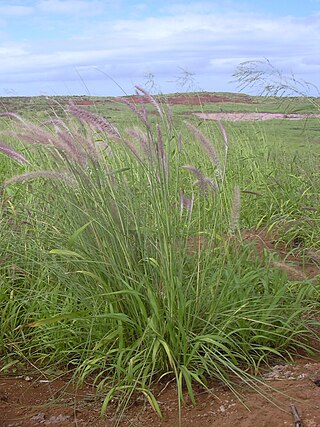
Cenchrus setaceus, commonly known as crimson fountaingrass, is a C4 perennial bunch grass that is native to open, scrubby habitats in East Africa, tropical Africa, the Middle East and south-western Asia. It has been introduced to many parts of the world as an ornamental plant, and has become an invasive species in some of them. It is drought-tolerant, grows fast, reaches 3 feet in height, and has many purple, plumose flower spikes.

Pennisetum is a widespread genus of plants in the grass family, native to tropical and warm temperate regions of the world. They are known commonly as fountaingrasses. Pennisetum is considered a synonym of Cenchrus in Kew's Plants of the World Online.

The northern hairy-nosed wombat or yaminon is one of three extant species of Australian marsupials known as wombats. It is one of the rarest land mammals in the world and is critically endangered. Its historical range extended across New South Wales, Victoria, and Queensland as recently as 100 years ago, but it is now restricted to one place, a 3 km2 (1.2 sq mi) range within the 32 km2 (12 sq mi) Epping Forest National Park in Queensland. With the species threatened by wild dogs, the Queensland Government built a 20-kilometre (12 mi)-long predator-proof fence around all wombat habitat at Epping Forest National Park in 2002.

Cenchrus is a widespread genus of plants in the grass family. Its species are native to many countries in Asia, Africa, Australia, the Americas, and various oceanic islands.

Parkinsonia microphylla, the yellow paloverde, foothill paloverde or little-leaved palo verde; syn. Cercidium microphyllum), is a species of palo verde.

Cyperus bulbosus is a species of sedge found across Africa, the Middle East, Indian subcontinent, Southeast Asia, and Australia. In Australia, it is commonly called Nalgoo or (Australian) bush onion or "wild onion", but is not related to the onion or other Alliaceae. It is a component of Australian bushfood, but is considered an agricultural weed in other areas.

Prosopis velutina, commonly known as velvet mesquite, is a small to medium-sized tree. It is a legume adapted to a dry, desert climate. Though considered to be a noxious weed in states outside its natural range, it plays a vital role in the ecology of the Sonoran Desert.

The tropical grass species Cenchrus clandestinus is known by several common names, most often Kikuyu grass, as it is native to the highland regions of East Africa that is home to the Kikuyu people. Because of its rapid growth and aggressive nature, it is categorised as a noxious weed in some regions. However, it is also a popular garden lawn species in Australia, New Zealand, South Africa and the southern region of California in the United States, as it is inexpensive and moderately drought-tolerant. In addition, it is useful as pasture for livestock grazing and serves as a food source for many avian species, including the long-tailed widowbird. The flowering culms are very short and "hidden" amongst the leaves, giving this species its specific epithet (clandestinus).

Bromus madritensis is a species of brome grass known by the common name compact brome. The specific epithet madritensis refers to Madrid, Spain. It has a diploid number of 28.
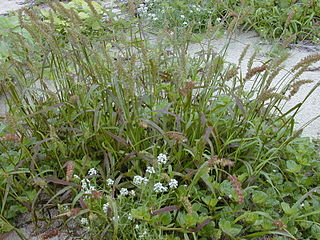
Cenchrus echinatus is a species of grass known by the common names southern sandbur, spiny sandbur, southern sandspur, and in Australia, Mossman River grass. It is native to North and South America.
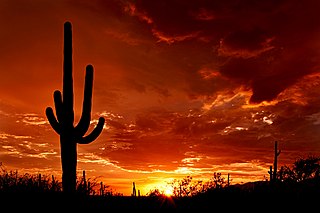
Saguaro National Park is a United States national park in Pima County, southeastern Arizona. The 92,000-acre (37,000 ha) park consists of two separate areas—the Tucson Mountain District (TMD), about 10 miles (16 km) west of Tucson, and the Rincon Mountain District (RMD), about 10 miles (16 km) east of the city. Both districts preserve Sonoran Desert landscapes, fauna, and flora, including the giant saguaro cactus.
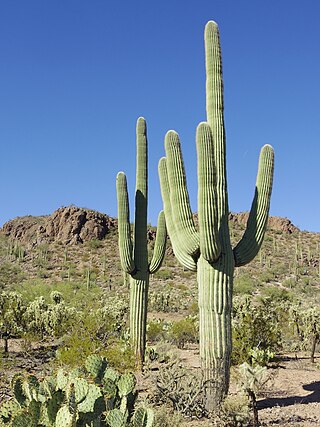
The saguaro is a tree-like cactus species in the monotypic genus Carnegiea that can grow to be over 12 meters tall. It is native to the Sonoran Desert in Arizona, the Mexican state of Sonora, and the Whipple Mountains and Imperial County areas of California. The saguaro blossom is the state wildflower of Arizona. Its scientific name is given in honor of Andrew Carnegie. In 1994, Saguaro National Park, near Tucson, Arizona, was designated to help protect this species and its habitat.

Megathyrsus maximus, known as Guinea grass and green panic grass, is a large perennial bunch grass that is native to Africa and Yemen. It has been introduced in the tropics around the world. It has previously been called Urochloa maxima and Panicum maximum. It was moved to the genus Megathyrsus in 2003.
Ambrosia cheiranthifolia is a rare species of flowering plant known by the common names South Texas ambrosia and Rio Grande ragweed. It is native to the coast of South Texas and the Mexican states of Tamaulipas and Coahuila. It occurs in coastal prairie, grassland, and mesquite shrubland habitat. It has declined because its native habitat has been cleared for development, with remaining open savanna invaded by non-native grasses such as buffelgrass. Today there are perhaps 20 populations remaining, but some of these may have very few genetic individuals because the species is clonal, with many cloned plants attached by one rhizome. It is not certain that the plant still exists in Mexico. This is a federally listed endangered species of the United States.

Escobaria robbinsorum is a rare species of cactus known by the common names Cochise pincushion cactus and Cochise foxtail cactus. It is native to southern Arizona in the United States, where it is known only from Cochise County, and northern Sonora in Mexico. There are scattered small occurrences on the north side of the border, and one known population to the south. Because of its rarity and a number of threats to remaining plants, the species was federally listed with a threatened status in 1986.
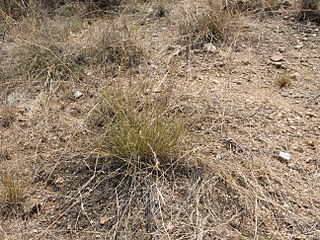
Eragrostis lehmanniana is a species of grass known by the common name Lehmann lovegrass. It is native to southern Africa. It is present elsewhere as an introduced species. It is well known as an invasive weed in some areas, such as Arizona in the United States.

Bothriochloa pertusa is a species of grass. It is widely used as a fodder and a graze for livestock.
Cenchrus pennisetiformis, commonly known in Australia as the Cloncurry, white or slender buffel grass, is a species of grass in the genus Cenchrus. It is native to parts of East Africa, the Arabian Peninsula and the Indian subcontinent, and has been introduced to some other parts of the world as a drought-tolerant forage crop.
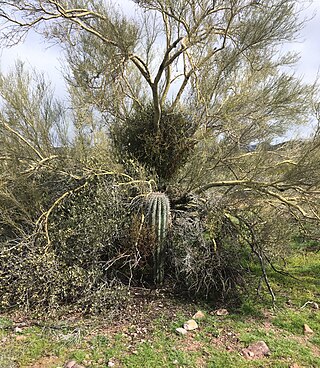
Nurse plants are plants that serve the ecological role of helping seedlings establish themselves and protecting young plants from harsh conditions. This effect is particularly well studied among plant communities in xeric environments.

Oncosiphon pilulifer, also known as globe chamomile and stinknet, is a flowering plant in the daisy family (Asteraceae) native to South Africa and Lesotho. It is considered invasive in some parts of North America.



















